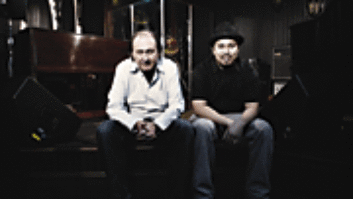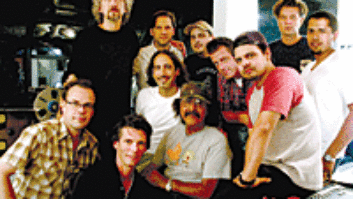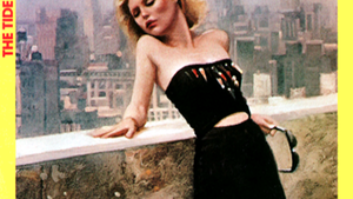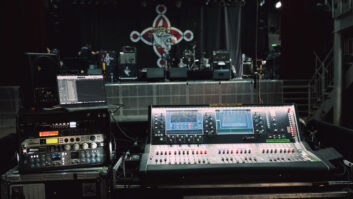It’s been five years since the release of Joan Osborne’s Top 10, multi-Platinum, major-label debut album, Relish, and three since she got off the road promoting it. That’s a long time to be without “product” (if you’ll excuse the record biz parlance) and out of the public eye. Sure, radio has continued to occasionally play her quirky smash hit, “One of Us” (and to a lesser degree, “St. Theresa”), and she had a song in the 1999 Kevin Costner baseball drama For the Love of the Game and dueted with Bob Dylan on the soundtrack for the TV miniseries The ’60s. But for someone who was on the cover of Rolling Stone and whose album placed high on many critics’ year-end lists, Osborne did quite a fade-out. Hell, even her record company, Mercury, forgot that she made them millions of dollars. When, after cutting a number of tracks for a new album with several different producers, she came to the label for an advance so she could record some tunes with the renowned producer Mitchell Froom (Los Lobos, Crowded House, Suzanne Vega, et al), instead of ponying up the cash, they dropped her from the label! How dumb is that? But that’s what the record business is like now: It doesn’t matter what you’ve done; if the label doesn’t smell big bucks, you’re gone.
“I was trying to make a record I liked, working with several different producers in a number of different situations, and I guess the label got tired of waiting,” Osborne told one writer. “It was a frustrating, difficult time, but it enabled me to make a fresh start. You gotta have a little faith, and as an artist, you can’t wait around for someone else to validate you. I was pretty confident that if I made a good record I’d have a place to go.”
Indeed. Teaming up with Froom, despite the lack of label support, turned out to be a brilliant move – they clicked immediately and together made an exceptional CD, Righteous Love, that was eagerly picked up by Interscope Records. The disc reflects Osborne’s tremendous growth as both a singer and songwriter. It’s brimming with smoldering R&B and rock grooves, strong and confident vocals, and imaginative instrumental arrangements that offer considerable textural variety under Osborne’s commanding voice. There’s a definite Middle Eastern influence in a couple of songs (a by-product of Osborne studying with the late, great Qawwali singer Nusrat Fateh Ali Kahn during her recording hiatus), some finger-poppin’ funk (including a raucous cover of Gary Wright’s “My Love Is Alive”), dashes of Beatles-inspired pop, gospel touches, and even an ethereal Dylan cover (“Make You Feel My Love”). It’s an eclectic melange, but Osborne has the voice and personality to pull it all together. There may not be a song on Righteous Love with the quirky, naive charm of “One of Us,” but the new CD is solid through and through. It’s that rare CD with no weak songs.
The CD ended up being relatively easy to make – it was recorded in just 28 days at the Sound Factory in L.A. by Froom and engineer John Paterno, then mixed by Bob Clearmountain at his Mix This! Studio. But for many months before Froom and Paterno got involved, Osborne was foundering, unsure of which direction she wanted to take the material. “She tried a bunch of different scenarios, and for whatever reasons they weren’t satisfactory to her,” Froom comments. “It’s daunting when you’re coming off a big success. It’s like for some reason nothing is ever good enough.
“We had originally talked a little bit back toward the beginning and the timing hadn’t worked out,” Froom continues. “I liked her, and we met up once or twice over those years, and at a certain point she was getting pretty frustrated, so finally I was in a position where I had some time and we were talking and I said, `Well, if you want, give me everything you’ve done so far and maybe we’ll try something.’ She originally talked to me about working on two songs, `Righteous Love’ being one of them because she thought I’d like that. And, when I heard the tapes, I liked quite a few of the songs, so I said, `Instead of looking at one song as a single kind of thing, I’d like to start in and do four or five songs, and if we like it we’ll just keep going.’ And she was into that idea.
“A lot of the songs had been cut to be records by various people, and there were different versions of different songs. There were a lot of very good ideas on these tapes they’d done. She had developed a lot of vocal ideas, and there were some musical things that were pretty good. But a lot of it seemed sort of sonically dark to me and not outgoing enough for her voice and the way she delivers things. So in talking to her and listening to what she had done, I developed a concept of the way I thought the record should sound.”
The first thing Froom did when he came onboard was bring in some of his favorite players to be a band on the record: The core group of drummer Pete Thomas (of Elvis Costello fame), bassist Davey Faragher and guitarist Val McCallum have played on many records in L.A., have worked as the backing band for Vonda Shepherd on (and off) Ally McBeal and even have a semi-serious club band called Jackshit (as in “you don’t know jackshit”) that plays unusual country and rock cover tunes. Besides being a producer, Froom is an accomplished keyboardist and arranger, so he plays on the album, too, and he enlisted sax player Steve Berlin of Los Lobos for a few cuts; all in all, it’s a cookin’ little unit that frames Osborne’s vocals wonderfully.
“She’s truly an amazing singer,” Froom says. “She didn’t feel her first record showed her vocal talent, and I’d have to agree. If all people have heard is `One of Us,’ they haven’t heard the real Joan. She’s not like a white pop singer. She has a lot of soul influence. You can hear blues and R&B in her phrasing. She’s also listened to a lot of Indian music, and we let that creep in there, too. It’s just a different kind of soul singing, really.”
Froom has used the Sound Factory as his main base of operations for nearly 15 years, and the studio has an illustrious history that stretches back many years before that, to the golden age of the L.A. singer/songwriter boom. Often Froom works in Studio B, but Righteous Love was cut in the larger Studio A; both rooms are equipped with API consoles, and the facility as a whole is noted for its fine mic collection and extensive outboard gear. Froom knows the rooms and the equipment inside out, and the same could be said for engineer John Paterno, who was an assistant at the Sound Factory for many years and first worked with Froom and his usual studio partner-in-compression, engineer Tchad Blake, on the groundbreaking Los Lobos album Kiko. Froom and Blake still work together often, “but more and more we’ve taken a break from each other, which is healthy,” Froom says. “John trained under Tchad for a long time, but over the past couple of years, since he’s stopped as a second engineer and established himself, he’s really come into his own. I thought the engineering on this record was magnificent.
“He doesn’t do what Tchad does at all,” Froom adds. “He has his own taste and the way he likes things. I think he likes things slightly less eccentric. But I know when he goes for something it’s going to be good. He doesn’t settle for any kind of weak engineering, and he’s really fast and easygoing, and he’s gotten into Pro Tools, which is very handy for some things. He’s a guy of the future. I know when Bob Clearmountain mixed it, he was very impressed with the quality of the engineering.”
Paterno notes, “I love what Tchad and Mitchell do, but I’m not Tchad; I don’t hear everything the same way he does. I have a different aesthetic. I don’t think I sound like him, but a lot of my approaches come from working with him. I’m indebted to him for the rest of my life because I learned so much from him. He’s a great friend of mine to this day. But I didn’t think for one second about it sounding or not sounding like this or that. I just did what I thought the music required, talking to Mitchell and Joan and the musicians and hearing the sounds they were starting with. My gig is to make everybody comfortable and to make it sound like a record as soon as possible.”
Most of the backing tracks were cut with the trio, plus Froom, laying down their parts live. A few arrangements began as loops cut to Pro Tools: On the Qawwali-influenced “If I Were Your Man,” for instance, “we created a loop for that rubber-bandy guitar figure, and that gave an atmosphere to start around,” Froom says. “That was a guitar tuned funny and then played by the drummer hitting it with a pencil [while McCallum did the fingering]. Then the notion was to surround that exotic sound with some things that were sort of pop.” The bass drum, snare and shakers on that tune were also looped.
Much of the art and innovation in Froom’s productions come from the choices that he and his musicians make in instrumentation and then, in conjunction with the engineer, determining how those instruments are recorded. He loves to combine instruments in unusual ways, loves to try different amplifiers, microphones and sonic treatments. For example, one of the hallmarks of his partnership with Blake, which Paterno also embraces, is using funky, old guitar effect pedals on drums and vocals.
I asked Froom if he keeps a zillion keyboards on hand to give himself as many options as possible. “Actually, I just had six or seven keyboards, but I had a lot of guitars and guitar pedals. Sometimes it’s a good idea not to have everything there because it gets way too crowded, and secondly you’re more likely to get more out of an instrument if you have less around. It forces you to try new things so you don’t settle quickly for things you’ve done before.
“I’m into textural combinations. Sometimes a song needs an actual rhythmic keyboard part that contributes to the combo sound, but I’m as likely to look for a guitar part. I primarily think of myself as an orchestrator, putting things together. A lot of that comes from the George Martin school, where you combine a few instruments to create a sound of a new instrument, or doing things in octaves or whatever to make them bigger.”
“There are a couple of things on this record that people are going to think are guitars but they’re actually Mitchell,” Paterno notes. “There’s a part on `Grand Illusion’ that’s a Wurlitzer through a ring modulator, and then on top of that there’s a high guitar note, and it’s panned together and becomes one sound, but it’s actually two different instruments.”
For the most part, McCallum’s guitars were recorded using an SM57 and a KM86 a couple of inches off whatever amp was chosen for a song. “We used mostly small amps, which is a Mitchell thing,” Paterno says with a chuckle. “We also ended up doing some direct guitar on this record. `Running Out of Time’ has that. We used a Les Paul a lot for direct sounds. `My Love Is Alive’ is a Fuzz Factory directly into the board.” Besides the Les Paul, McCallum’s arsenal included various Telecasters, a Fender Jaguar, a Gibson Firebird and a White lap steel. “The room where we had the guitars is really bright,” Paterno notes. “It has plaster walls and a linoleum floor. It’s really ambient and sounds great. I think it was the lobby of the Studio A building when it was originally designed and built for the Stones by [producer] David Hassinger. I don’t think the Stones ever set foot in the building, though.”
Osborne was in a nearby vocal booth singing into a Telefunken 251, run through a Hardy M-1 preamp and an ADL 1000 compressor directly to tape, which was BASF 911 24-track, 15 ips with Dolby SR. “The vocals and drums didn’t go through board mic pre’s,” Paterno comments, “though the drums were bused together using the console, and sometimes I might have even added a little API EQ after the Neve modules used on the kick, snare, toms and overheads; those were all Neve 1073s.”
As for drum miking, Paterno likes to experiment with different combinations and notes: “I also usually have this mono trashy thing going on. I put up a couple of mics around the kit – sometimes it’s just an Altec salt shaker that I leave on the floor underneath the snare drum and it immediately sounds like distortion. So I’ll put up a couple of mics and if I want a more distant sound, if I’ve got a mic, like a Sennheiser 441 or a U47 a little further away from the kit, I’ll bring that up and put it through some kind of compressor or Dynacomp or something. And that’s usually blended into the big picture. That’s something I got from Tchad – great sounds and then some mangled things to go along with it.
“‘My Love Is Alive’ had a completely different approach,” he continues. “The phaser on that was printed. It was a Moog phaser on one of the overheads, and then I gated the drums quite a bit and had a couple of 87s up in the room and pounded them with an 1176 or a Spectrasonic 610.”
The 610 is part of the arsenal of equipment that Paterno personally owns. Some of the other gear he brought includes Hardy preamps, Amek 9098 EQs, Calrec PQ15 EQs, Little Labs DIs, various guitars and pedals, Sansamps and a Distressor, which he says is “the best piece of gear to come out in the last several years.”
Rather than recording the songs piecemeal over an extended period and then putting it all together, the musicians and technical team “worked on one song at a time,” Paterno says. “We’d do one song completely before we’d move on, including fixes and overdubs. We’d do tracking one day, then do the vocal the next morning, then overdubs, and when we ran out of tracks it was done,” he says with a laugh. Osborne’s vocals were usually comped from just a few takes, and in the case of “My Love Is Alive,” “We got the track, and Joan went out and sang it once; she nailed it,” Froom says. For the couple of songs that required strings, Froom eschewed using a large orchestra – “I usually don’t get a big section,” he says. “I’m a bit intimidated by it. So I usually just get about six people and then make sure that it works right and then track it.” (Two of the songs on the album came from the sessions that took place before Froom and Paterno got involved, though some new parts were added to them.)
After the month of recording, Froom and Paterno turned the tapes over to master mixer Bob Clearmountain. Froom says, “I took the roughs and met with Bob and talked to him conceptually. I told him I wanted it a bit more raw than some of the things people associate with him, but at the same time you still want it to be like one of his mixes that sounds great on all systems. I wanted his version of in-your-face raw and loose and funky; not too polished. Some of the mixes are magnificent, like `Angel Face’ and `Hurricane.’ And I couldn’t even tell you exactly what he did; it’s just a way that he has of putting things together and how he puts things in their own space and the dimension he creates. Even on some of the panning, he went a different route than he did on some of the things I’ve worked on with him before. For a record like this to come out great you’ve got to give people space. You’ve got to hire the right people but then give them as much space as you can and kind of go with their concept as much as you can.”
“It was a team effort all the way,” Paterno agrees. “In a way, everybody had something to prove and everybody really stepped up.”
Osborne wanted to prove that she could successfully follow up Relish. Paterno wanted to show that he could handle such an important, high-profile project. And Mitchell Froom wanted to break out of his pigeonhole as a guy who makes sonically adventurous but not particularly commercial records.
“With Joan, there will probably be some people who are horrified that I worked on it, thinking that I’m going to make it completely, willfully strange,” Froom says. “But the reality is I look at each record in a very different way. I’m more and more now of the frame of mind that if you set out to make a pop record, you make a pop record, and hopefully you make a cool one that’s not completely generic, and hopefully it shows the personality of what the band or the singer’s about. In Joan’s case we did what we thought was a cool pop version of what she’s about. We could have made a very dark, bizarre record all based on strange sounds, and it would’ve worked, but it never would’ve been released.
“An engineer told me that some record company guy had screamed at him, `I don’t want this sounding like a Mitchell Froom-Tchad Blake record’; like, `Don’t do anything weird.’ In the late ’80s I was thought of as this kind of pop guy, and when the ’90s came we did [Los Lobos’] Kiko and people started to say, `Oh, they’re up to something interesting.’ Then a few more years go by and you’re suddenly pigeonholed in this other way. It’s the same with musicians, it’s probably the same for writers – that the very thing you’re loved for you’re all of a sudden despised for. So in order to survive, you have to reinvent yourself while holding on to your integrity and continuing to do interesting stuff. And Joan’s album fits in with that. It was a situation where everything was right. There were very few failures and it felt lucky and it was real exciting. It just flew together.”





